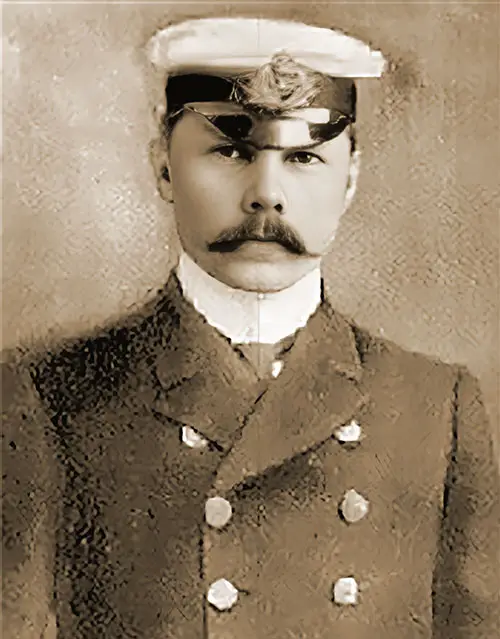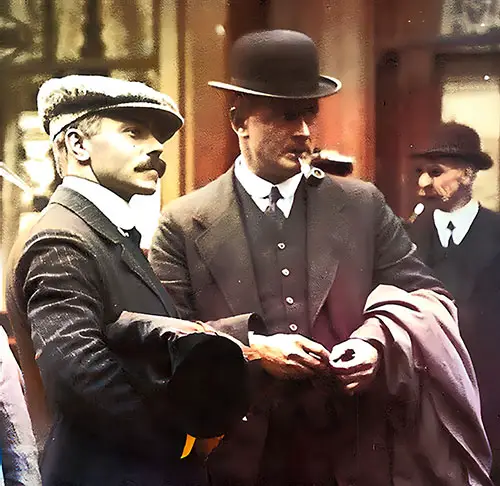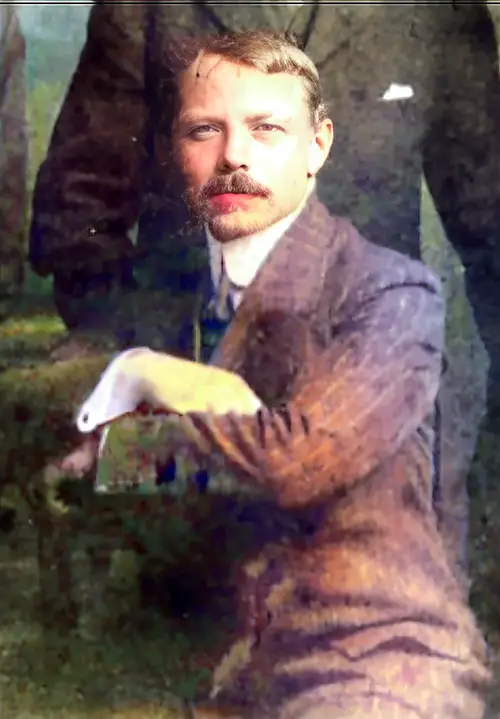Third Officer Herbert Pitman: A Titanic Survivor’s First-Hand Account
📌 Learn about Third Officer Herbert Pitman’s role on the Titanic, his testimony about the ship’s final moments, and the controversial decision not to return for drowning passengers. Essential for students, historians, and maritime researchers.

34-Year Old Third Officer of the RMS Titanic, Mr. Herbert John Pitman. GGA Image ID # 1702ec33a3
Third Officer Herbert Pitman – A Titanic Eyewitness Account 🚢⚓
The "Third Officer Herbert Pitman" section provides a first-hand account from a senior crew member aboard the Titanic. Pitman was in command of Lifeboat No. 5, witnessed the Titanic’s final moments, and later testified in the U.S. Senate inquiry. His perspective offers unique insights into the disaster, evacuation procedures, and the ethical dilemmas faced by survivors.
This detailed profile covers:
✅ Pitman’s maritime career & role as Third Officer
✅ His observations of iceberg warnings & Titanic’s speed
✅ The moment of impact and his reaction upon waking up
✅ His testimony about why Lifeboat No. 5 didn’t return for survivors
✅ His first-hand description of the Titanic’s final plunge
This article is highly relevant for:
✅ Teachers & Students – Titanic leadership decisions, maritime safety, and survival ethics
✅ Genealogists – Researching crew members & their actions
✅ Historians & Maritime Enthusiasts – Eyewitness accounts of Titanic’s sinking
✅ Anyone studying the Titanic disaster – Uncovering the ship’s speed, iceberg warnings, and evacuation procedures
📌 Encourage students to use these materials when writing essays on Titanic crew decisions, navigation errors, or eyewitness reliability.
Herbert Pitman Fast Facts
- Full Name: Herbert John "Bert" Pitman, MBE
- Date of birth: 20th November 1877
- Place of birth: Sutton Montis, Castle Cary, Somerset, England
- Marital status: Married
- Spouse: Mimi Kalman
- Crew position: Titanic's Third Officer
- Date of death: December 7, 1961
- Cause of death: Subarachnoid hemorrhage, aged 84
The 34-year-old Third Officer Herbert J. Pitman. Pitman, though rather short in stature, was an imposing figure with his pronounced mustache. He was also an extremely capable officer with sixteen years of experience at sea.
At the time of the Titanic disaster, his resume included four years with James Nourse (Ltd.), as an apprentice; three years as an officer in the same employ; about twelve months in the Blue Anchor Line, running to Australia; six months in the Shire Line, running to Japan; and five years with the White Star -- Second, third, and fourth officer; second officer for two months on the Dolphin, the Majestic, Oceanic, and the Titanic. He held a master's certificate seven years from the board of trade.
His duties on the Titanic comprised of working out celestial observations, finding the deviation of the compass, general supervision around the decks, and looking after the quartermasters; also relieving the bridge if necessary.

Charles Lightower (on right) with RMS Titanic Third Officer Herbert J. Pitman in late April 1912. GGA Image ID # 1702d14210
Herbert J. Pitman, third officer, was the first witness of the day. It had been expected that J. B. Boxhall, fourth officer, would be recalled, but it was announced he was ill.
Pitman said that in the boat drill conducted by the board of trade at Southampton approximately eight men went in each of the two boats used in the drill. The witness maintained that virtually the only way to discover the proximity of icebergs was to see them, asserting that, while science may hold there are numerous ways, they never have been demonstrated.
Pitman was on the bridge of the Titanic from 6 to 8 o'clock the night of the collision. After that he went to his berth. Half asleep at the time of the accident, he said he wondered sleepily where they were anchoring.
It was nearly time for his next watch, so he dressed leisurely and was lighting his pipe when Mr. Boxhall told him the ship had struck an iceberg. He went forward and saw ice, and then walked back, where a number of firemen coming up told him there was water in the hatch.
Going on deck he met a man whom he afterward learned was Mr. Ismay, who said, “Hurry, there's no time for fooling.” Mr. Ismay helped him load the boat in which Pitman embarked on orders from Mr. Murdoch after calling for more women passengers and finding there was none in sight.
The witness said that just before the boat pulled away Mr. Murdoch leaned over, shook his hand, and said, “Good-by and good luck, Old man.”
“When you shook hands with Murdoch did you expect to see him again?”
“Certainly.”
“Do you think he expected to see you again?”
“Apparently not, but I expected fully to be back on the ship in a few hours.”
Pitman told of the placing on the chart of crosses indicating the presence of icebergs by the fourth officer and said that the speed had been increased from twenty and one-half knots on leaving Southampton to twenty one and one-half knots and that he supposed the ship was going at top speed when it struck. The witness said he had not seen any Morse signals on the Titanic and did not of his personal knowledge know of the presence of another ship, but that he later had heard that one had passed.
Senator Smith referred to Third Officer Pitman’s testimony in which he said there were thirty-five persons in lifeboat No. 5. That being the case, he asked why Pitman could not have gone to the rescue of the drowning, whose cries he heard plainly, but did not heed.
“Had he attempted to rescue those in the water he would have endangered the lives of those with him,” Lowe asserted.
Other Excerpts
Third Officer Herbert John Pitman of the Titanic appeared for a minute on the stand just before adjournment was taken, but he answered one question only, as to the fate of the log. So far as he knew, that important document today is at the bottom of the sea.

Blown-up Section Showing Herbert John Pitman Taken From a Photo of the Four Surviving Senior Officers of the RMS Titanic Circa 1913. GGA Image ID # 17033f4a3b
Third Officer’s Testimony
Mr. Pitman, tho third officer, was oxamined first. Mr- Pitman had been in bed at the time of the shock. On dressing and going on deck he was rnet by Mr. Lenay, who told him in a low voice that the thing was serious and that the women and children must be put into the boats.
Mr. Pitman went to tho captain for his orders before setting to work. Mr. Ismay holpod him and Murdock and tho other officers, and when Murdock ordered Pitman into a boat Mr. Ismay was still on the deck.
It was a collapsible boat in which Mr. Ismay eventually found a place after no more women could be found. Mr. Pitman testified that 'there had been no boat drill since tho ship left Southampton, though both boat and fire drills were, he said, usually held on Sundays.
He further said that the canvas bucket for taking the temperature of tbe water was wanting and an ordinary tin bucket was used instead. The boats were not filled to their limit bocause there wore not enough womon on deck. It was not made cloar why, in default of women, men were not taken. - 22 April 1912, Senate Inquiry.
Digest of Testimony
COLLISION, EFFECT OF:"A sound like the ship coining to anchor * * * just a little vibration," Officer Pitman
DISTRESS SIGNALS FIRED: "About a dozen rockets were fired," Officer Pitman
ICE: "The chart showed icebergs away to the north of the track," Pitman
"The iceberg was to the northward of the southerly track, between the northern and southern track," Pitman
"We were keeping a special lookout for ice * * from 10 o'clock on," Officer Pitman
SEARCHLIGHTS: "Might have revealed ice," Officer Pitman
SHIP LIGHT IN DISTANCE: "We waited until we were certain it waa a steamer, and then pulled toward her," Pitman
SHIP SINKING: "Turned right on end and went down perpendicularly," Pitman
"Did not break in two," Pitman
SHIP SINKING, EXPLOSIONS: "Four. Assumed it was bulkheads going," Pitman
SPEED: "About 21 1/2 knots—20 1/4, 20 1/2, 21, 21 1/2," Officer Pitman
WATER ADMITTED TO SHIP: " I saw the water flowing over the hatch No. 1 in firemen's quarters," Officer Pitman
No. 5 boat: Loaded by Officer Pitman, assisted by Mr. Ismay
Pitman ordered in by Murdock
No. 7 boat (first starboard boat): Between 30 and 40, Pitman
RMS Titanic Third Officer, Herbert J. Pitman
The 34-year-old Third Officer Herbert J. Pitman. Pitman, though rather short in stature, was an imposing figure with his pronounced mustache. He was also an extremely capable officer with sixteen years of experience at sea. After the Titanic, H. J. Pitman served as thrid officer of the RMS Oceanic.
The Life & Career of Herbert Pitman
📜 Most Engaging Image:
🔹 "34-Year-Old Third Officer of the RMS Titanic, Mr. Herbert John Pitman."
💡 Why It Matters:
Pitman was an experienced officer with 16 years at sea, including time on other White Star Line ships.
His expertise in celestial navigation and compass deviation made him a valuable officer.
His career continued after the Titanic, serving as Third Officer on the RMS Oceanic.
📌 For students studying maritime careers, Pitman’s background illustrates the training and hierarchy aboard luxury liners.
🚨 Titanic’s Collision & Pitman’s Initial Response
📜 Most Startling Detail:
🔹 "I was in my berth, half-asleep, when I heard a sound like the ship coming to anchor."
💡 Why It Matters:
🔹 Pitman initially believed the Titanic was stopping to anchor rather than colliding with an iceberg.
🔹 He took his time dressing and lighting his pipe before realizing the severity of the situation.
🔹 This slow response mirrors other crew members’ disbelief, reinforcing how unsinkable Titanic was perceived to be.
📌 For essays on human error, Pitman’s reaction highlights how denial played a role in the slow emergency response.
🌊 Titanic’s Speed & Iceberg Warnings: What Did Pitman Know?
📜 Key Eyewitness Quote:
🔹 "The speed had been increased from twenty and one-half knots on leaving Southampton to twenty-one and one-half knots. I suppose the ship was going at top speed when it struck."
💡 Why It Matters:
🔹 Titanic was sailing at full speed despite iceberg warnings.
🔹 Ice locations were marked on charts, but no course adjustment was made.
🔹 Pitman later testified that there were no special lookouts assigned for ice that night.
📌 For students writing about Titanic’s safety failures, Pitman’s testimony is crucial evidence.
🛟 Lifeboat No. 5: Did Pitman Ignore Drowning Passengers?
📜 Most Controversial Decision:
🔹 "I heard the cries of the drowning plainly, but we did not turn back. We might have endangered the lives of those with us."
💡 Why It Matters:
🔹 Pitman was ordered to command Lifeboat No. 5 and lower it into the water with 35 passengers—far below its 65-person capacity.
🔹 After Titanic sank, he heard the desperate cries of passengers in the water but decided NOT to return.
🔹 This remains one of the most debated moral dilemmas of the Titanic tragedy.
📌 For essays on survival ethics, this moment raises key questions about lifeboat decisions.
🚢 Titanic’s Final Moments – What Pitman Witnessed
📜 Most Harrowing Detail:
🔹 "The ship turned right on end and went down perpendicularly. It did not break in two."
💡 Why It Matters:
🔹 Pitman’s testimony contradicts modern findings—we now know Titanic broke in half before sinking.
🔹 This highlights how eyewitness accounts under trauma can be unreliable.
🔹 He also reported hearing explosions, likely from bulkheads failing.
📌 For students analyzing survivor testimonies, Pitman’s account shows how memory and perception can be flawed under stress.
⚖️ Pitman’s Role in the Titanic Inquiry
📜 Most Revealing Inquiry Testimony:
🔹 "The boats were not filled to capacity because there were not enough women on deck. It was not made clear why, in default of women, men were not taken."
💡 Why It Matters:
🔹 Pitman confirmed that lifeboats were launched half-full despite hundreds still onboard.
🔹 He revealed that no lifeboat drill was conducted after Titanic left Southampton.
🔹 His honest but limited testimony helped shape post-Titanic safety reforms.
📌 For researchers studying maritime law, Pitman’s testimony contributed to requiring lifeboats for all passengers on future ships.
📝 Key Takeaways for Students & Researchers
📖 Why Pitman’s Story Matters:
✔ Analyzing lifeboat ethics—why some officers refused to return for passengers in the water
✔ Understanding Titanic’s speed & navigation decisions—did the crew ignore the iceberg warnings?
✔ Examining eyewitness testimonies—how trauma & chaos affected survivors’ accounts
✔ Learning from the Senate Inquiry—how Pitman’s statements led to improved maritime safety laws
📌 For essay topics, consider:
"Could more lives have been saved if Lifeboat No. 5 had returned?"
"Why did Pitman believe Titanic sank in one piece, despite evidence to the contrary?"
"How did Pitman’s testimony contribute to post-Titanic safety laws?"
⚡ Final Thoughts: Pitman’s Titanic Legacy
Herbert Pitman’s experience aboard Titanic highlights the moral and logistical dilemmas faced by crew members during a rapidly escalating disaster.
🕊️ His testimony remains one of the most valuable first-hand accounts of the sinking, even as some of his recollections were later contradicted by physical evidence.
📚 For deeper research, explore the GG Archives for rare Titanic crew records, survivor testimonies, and maritime disaster studies.
🚀 Encourage students to use Pitman’s story to explore leadership, decision-making, and eyewitness reliability in disaster scenarios.
🔎 Looking for more? Browse the GG Archives for Titanic’s deck plans, crew lists, and official inquiry transcripts!
🌊 History remembers Herbert Pitman as an officer who followed orders, but his actions raise lasting ethical questions about the Titanic’s final hours.
